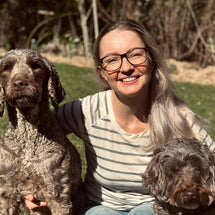Biofilm and the importance of washing your dog’s water bowl

Regularly cleaning your dog’s water bowl is a crucial and often overlooked responsibility. That layer of slime in your dog’s water bowl isn’t just gross, it’s a real health hazard; all thanks to a thing called ‘biofilm’.
What is biofilm?
Biofilm is a layer of microorganisms within a matrix, comprised of bacteria and fungi, adhering together on a surface as a slime. You might have felt this slippery bad guy after running your finger across the inside of an unwashed water bowl or food dish. Biofilm in water and food bowls can be responsible for diarrhoea, vomiting, dental disease, and even spreading infections such as kennel cough.
How does biofilm form?
Biofilm forms when bacteria and fungi adhere to surfaces, such as the inside of a water dish, to produce a slimy matrix that traps food particles, debris, and more bacteria. This slime is difficult to remove, allowing harmful bacteria to survive and multiply effectively. Biofilm matrixes start to form after only 24 hours.
Where does biofilm come from?

The main source of biofilm in water bowls is bacteria from your dog’s mouth. Plaque is a type of biofilm which accumulates on teeth and periodontal tissues, causing gingivitis and periodontitis.
Once you realise how much bacteria there is in the world around us, it’s no wonder biofilm accumulates in your dog’s water bowl.
The main culprits are:
-
Your dog’s oral bacteria and saliva are the main source of biofilm in dog water bowls. The canine oral cavity contains over 600 different bacterial species, and their skin is home to thousands of types of bacteria.
-
Food particles accelerate biofilm establishment and persistence by acting as a scaffold to help bacteria adhere to the inside of the water dish, but also by providing an ongoing nutrient source, encouraging faster microbial growth.
- Your dog’s friends: for the same reason why humans shouldn’t share water bottles, communal water bowls are fomites for infectious diseases like Kennel Cough, Canine Distemper Virus and bacterial gut infections from Salmonella. This is just another reason to avoid visiting the dog park with your young puppy until they’re fully vaccinated.
-
Environmental contaminants such as dirt, grass, insects, worms, bird poo, dog poo… the world is a pretty diverse biome. These things are usually fine when dropped into a flowing river, but they proliferate and become hazardous if left to fester in a stagnant bowl of water.
How to stop biofilm
Biofilm can only be removed mechanically, through scrubbing.
- Regular cleaning: Wash water and food bowls thoroughly, ideally every day. Once a week, do a deep clean disinfection.
- Provide fresh water daily: Providing fresh water for your dog every day, or more frequently, helps reduce biofilm formation by minimising the buildup of bacteria and nutrients that promote microbial growth.
- Avoid plastic bowls: Opt for stainless steel bowls instead of plastic, as they are less porous, don’t scratch as easily and are easier to clean, reducing hiding places for biofilm to form.
-
Maintain dental health: Keep up with a consistent dental routine, including daily brushing and regular professional cleans under anaesthetic to improve your dog’s overall health, as well as to reduce biofilm forming in their water bowl.
Swap the slime for the sublime, and fill your dog’s bowl with Petzyo’s kibble recipes.
- Automatic water filters: Undeniably fancy, commercial pet water fountains come with a filtration system to stop bacteria and algae formation. If you’re interested, try to find one that is made of stainless steel rather than plastic. Bowls with filters still need to be cleaned, mostly through a daily wipe-down, and regular deep cleaning at least once a week.
Remember: Don’t ever use human toothpaste for your dog as the fluoride levels are too high!
Why dirty water bowls are unhealthy

Dirty water and food bowls are more than just an aesthetic problem. They can act as reservoirs for pathogenic bacteria with the potential to cause dreadful episodes of diarrhoea and vomiting and spread Kennel Cough (Bordetella bronchiseptica).
Persistent microbial contamination in bowls also contributes to the oral biofilm and plaque that worsens dental disease (gingivitis and periodontitis), cycling bacterial infections between mouth, skin and the environment.
Cane Toad Alert! In Queensland, the Northern Territory, northern New South Wales, and small parts of Western Australia, water bowls can become contaminated with cane toad saliva, which contains bufotoxins that are highly toxic to dogs and cats and can produce drooling, collapse, shaking, seizures and dangerous cardiac episodes. Learn what to do if your dog is poisoned by a toad.
How often should you clean your dog’s water bowl?
Water bowls should, ideally, be cleaned every day. Microbial attachment and the slimy biofilm matrix start to form within about 24 hours. Daily washing stops that process to reduce bacterial numbers.
Feeding a raw food diet? Remember to always clean your dog’s food bowl as soon as they’ve finished eating and within 30 minutes. Always wash your hands and surfaces after meal-prep.
How to clean your dog’s water bowl
-
Daily: Use hot water, regular dishwashing liquid, a brush and elbow grease to get right into the crevices. Alternatively, putting the bowl through a dishwasher cycle above 65 °C will do the trick too!
-
Brush type: The best kind of brush to use is a soft silicone brush, as these aren’t abrasive and are easier to keep clean. Remember to keep the brush clean and dry between uses.
-
Weekly: For a ‘deep-clean’ disinfection of their water bowl, use a pet-safe product such as vinegar, and soak for 5-10 minutes, then rinse and wipe dry. If using bleach-based products, ensure to rinse well before re-use.
So banish the biofilm, and your dog will repay you with slobbery kisses and grateful tail wags that say “You’re the best… Now fill my dinner bowl!”
References
-
Vestby LK et al. Bacterial biofilm and its role in the pathogenesis of disease. Antibiotics (Basel) . 2020;9(2). https://www.mdpi.com/2079-6382/9/2/59
-
Clutterbuck AL et al. Biofilms and their relevance to veterinary medicine. Veterinary Microbiology. 2007;121(p1-17). https://www.sciencedirect.com/science/article/abs/pii/S037811350600527X
-
Sharma S et al. Microbial Biofilm: A review on formation, infection, antibiotic resistance, control measures and innovative treatment. Microorganisms. 2023;11(6), 1614. https://www.mdpi.com/2076-2607/11/6/1614
-
Toad poisoning in pets. Animal Referral & Emergency Network. https://www.emergencyvet.com.au/for-vets-and-nurses/resource-centre/pet-parent-education-hub/emergency-first-aid-for-a-pet-with-toad-poisoning.html





